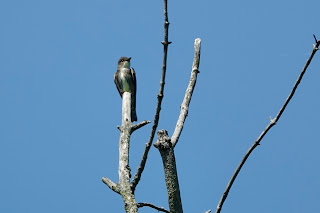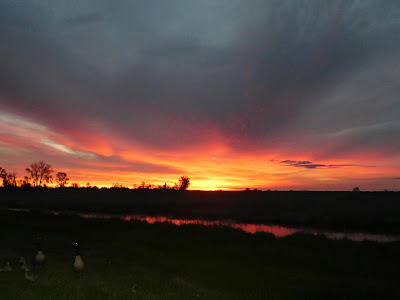Twarted by a Connecticut Warbler that was seen by others in Nichols Arboretum on Saturday, the 18th, I checked the weather for Sunday and saw that it would be sunny and hot. I decided I would leave my house at 5:00 am and drive down to Magee Marsh, Ohio to arrive at sunrise. When my alarm went off at 4:30 am, I nearly cancelled on myself. I'm glad I didn't. By Magee Marsh standards the crowd was moderate, and while there were not a hoard of birds, there was plenty to keep it fun and interesting all day. When it came time, I didn't want to leave. The birds were still showing but were slowing down as it became hotter and hotter. I met a young couple, originally from South Asia and now from Perrysburg, Ohio, with who I spent a couple of companionable hours.
Above and below: The Philadelphia vireo landed on a horizontal branch right over the boardwalk, caught a mayfly, and then spent time wrestling with it.
Each year I settle on a bird that I have not seen in a while and decide that, this year, I'll try to see the bird. I had not seen a Philadelphia Vireo in many years. On my drive down I was hoping that this might be the day. I knew my visit was in their general arrival window. For my money, and as vireos go, the Philadelphia wins the cuteness prize. Although plain enough, I find it to be a very attractive bird. So, when I saw two birds, and was able to get such nice photos of one, it was thrilling.
The birds stuck around in the same area and continued to be seen by others. At least two hours later I took my new friends (from Perrysburg) to the Philadelphia vireo spot - the guy had a big camera - to see if we could re-find the bird. Of course we did. I don't know how his photos turned out. Fingers crossed, they were good. As far as I know I am the only one to have these very close, perched photos right over the boardwalk. I tried to attract the attention of others but failed. The word vireo is not warbler and no one paid any attention. In hindsight I'm happy about that. The bird would surely have flown if others began pointing big cameras at it.
If anyone actually reads this, they might be thinking "come on, Philadelphia Vireo is not rare." True enough, but it is not as common as its more numerous and vociferous cousins, the Warbling and Red-eyed vireos, and it is easy to overlook. A birder needs to work a little to see the Philadelphia Vireo.
Later the guy half (of my new Perrysburg friends, via South Asia, and who were also new to birding) asked, "why is it called Philadelphia vireo?" I thought, now there's a question. I didn't know how to explain to him the history of naming North American birds by Alexander Wilson, John James Audubon and others. By way of trying to answer, I did say that birds named after people are being reviewed and, over time, will change. He looked puzzled and asked, "why?" Now I was really stuck. I responded, "well, it's complicated."
I'm currently reading The Birds That Audubon Missed by Kenn Kaufman (2024) and it is excellent! I'm a slow reader, but will be publishing a review when I've finished reading.
______________________________
Addendum 05/21/2024: I'm on chapter three and Kenn Kaufman has already mentioned John James Audubon's Ornithological Biography several times. Five volumes of Ornithological biography, or An account of the habits of the birds of the United States of Americas are downloadable from the Library of Congress. So back to my friend's question, I was thinking, but had no way to know for sure, that the bird was found, described and named by Audubon in Philadelphia only because Audubon had lived, for awhile at least, in Philadelphia. But searching a little more, all of the recognized naturalists of that time period either lived in or had passed through Philadelphia. Anyway Audubon never painted the Philadelphia Vireo. He painted Red-eyed, Solitary (now Blue-headed), Warbling and White-eyed vireos.
From the Cornell Lab: All About Birds: Philadelphia Vireo was named in 1851 by American ornithologist John Cassin, who described the species based on a specimen of a migrant in Philadelphia. A local name for the species in that city was once “Brotherly-love Vireo.”
What is for certain, when the American Ornithological Society gets to it, John Cassin will have his own honorifics changed. Cassin's Sparrow (Peucaea cassini), Cassin's Finch (Haemorhous cassini) and Cassin's Kingbird (Tyrannus vociferans) will all receive new names. Tyrannus vociferans may have been identified and described by someone other than John Cassin himself. Perhaps one of his proteges named it in his honor? Otherwise, why would Cassin not have named it Tyrannus cassini?
Second addendum 05/23/24: In chapter 5 of The Birds That Audubon Missed, Feuding in Philadelphia, page 162, Kenn Kaufman writes: "Far more elusive in a historical sense was the Philadelphia Vireo which managed to evade Wilson, Audubon, and all their contemporaries. John Cassin introduced it to Western science in a paper about the vireo family that he presented to the Academy of Natural Sciences of Philadelphia in February 1851 - only weeks after Audubon had passed away at his home in New York."
Although, I had trouble finding the Philadelphia Vireo in the writing, this is almost certainly the paper referenced by Kenn Kaufman. Very interesting to see how, in those days, a published paper appeared.
Reading Kenn Kaufman's book, we learn that the early naturalists - again, Wilson, J.J. Audubon and others - also had a lot of trouble with the Catharus genus They thought, when seeing those five species, they were looking at the same bird - Swainson's Thrush. Even the Veery, which I think looks quite different, got caught up in this confusion. They did, however, recognize Wood Thrush (Hylocichla mustelina) as a different genus and species.
In this same way, Philadelphia Vireo may have been overlooked secondary to confusing it with Red-eyed and Warbling vireos.
______________________________
Finally, and semi-on-topic for excellent reading for birders, environmentalists, ecologists and people who just enjoy reading great writing, I also highly recommend The End of the End of the Earth (essays) by Jonathan Franzen (2018). I'm also going to review this book (when I get time).














































